Flow and Heat Transfer Past a Stretching/Shrinking Sheet Using Modified Buongiorno Nanoliquid Model
Abstract
:1. Introduction
2. Mathematical Model
3. Solutions of the System
- There is no any physical solution when .
- A unique solution is gotten if .
- Dual solution can be only obtained for .
- no solution when and ,
- a unique solution if , and
- dual solution at ,
4. Results and Discussion
5. Conclusions
- One solution exists for stretching sheet .
- Dual solutions exist for shrinking case ).
- Skin friction coefficient and the local Nusselt number are increased as the rate of suction is increased.
- The analysis of the present investigation plays a predominant role in the applications of science and technology. Particularly, the results of the present problem are of great interest for controlled metal welding or the magnetically controlled coating of metals in fusion engineering problems, polymer engineering, metallurgy, and so forth.
Author Contributions
Funding
Institutional Review Board Statement
Informed Consent Statement
Data Availability Statement
Conflicts of Interest
References
- Choi, S.U.S. Enhancing thermal conductivity of fluids with nanoparticles. In Proceedings of the 1995 ASME International Mechanical Engineering Congress and Exposition, San Francisco, CA, USA, 12–17 November 1995; ASME FED 231/MD 66. pp. 99–105. [Google Scholar]
- Buongiorno, J. Convective transport in nanofluids. ASME J. Heat Transf. 2006, 128, 240–250. [Google Scholar] [CrossRef]
- Mahian, O.; Kianifar, A.; Kalogirou, S.A.; Pop, I.; Wongwises, S. A review of the applications of nanofluids in solar energy. Int. J. Heat Mass Transf. 2013, 57, 582–594. [Google Scholar] [CrossRef]
- Manca, O.; Jaluria, Y.; Poulikakos, D. Heat transfer in nanofluids. Adv. Mech. Eng. 2010, 27, 380826. [Google Scholar] [CrossRef]
- Kamel, M.S.; Lezsovits, F. Boiling heat transfer of nanofluids: A review of recent studies. Therm. Sci. 2019, 23, 109–124. [Google Scholar] [CrossRef] [Green Version]
- Aly, E.H.; Sayed, H.M. Magnetohydrodynamic and thermal radiation effects on the boundary–layer flow due to a moving extensible surface with the velocity slip model: A comparative study of four nanofluids. J. Magn. Magn. Mater. 2017, 422, 440–451. [Google Scholar] [CrossRef]
- Babu, J.A.R.; Kumar, K.K.; Rao, S.S. State-of-art review on hybrid nanofluids. Renew. Sustain. Energy Rev. 2017, 77, 551–565. [Google Scholar] [CrossRef]
- Huminic, G.; Huminic, A. Hybrid nanofluids for heat transfer applications—A state-of-the-art review. Int. J. Heat Mass. Transfer. 2018, 125, 82–103. [Google Scholar] [CrossRef]
- Fisher, E.G. Extrusion of Plastics; Wiley: New York, NY, USA, 1976. [Google Scholar]
- Karwe, M.V.; Jaluria, Y. Numerical simulation of thermal transport associated with a continuously moving flat sheet in materials. J. Heat Transf. 1991, 113, 612–619. [Google Scholar] [CrossRef]
- Sakiadis, B.C. Boundary-layer behavior on continuous solid surfaces: I. Boundary-layer equations for two-dimensional and axisymmetric flow. AIChE J. 1961, 7, 26–28. [Google Scholar] [CrossRef]
- Aly, E.H.; Pop, I. MHD flow and heat transfer near stagnation point over a stretching/shrinking surface with partial slip and viscous dissipation: Hybrid nanofluid versus nanofluid. Powder Technol. 2020, 367, 192–205. [Google Scholar] [CrossRef]
- Aly, E.H.; Rośca, A.V.; Rośca, N.C.; Pop, I. Convective heat transfer of a hybrid nanofluid over a nonlinearly stretching surface with radiation effect. Mathematics 2021, 9, 2220. [Google Scholar] [CrossRef]
- Waini, I.; Ishak, A.; Pop, I. Hybrid nanofluid flow towards a stagnation point on an exponentially stretching/shrinking vertical sheet with buoyancy effects. Int. J. Numer. Methods Heat Fluid Flow 2021, 31, 216–235. [Google Scholar] [CrossRef]
- Khashi’ie, N.S.; Arifin, N.M.; Pop, I.; Nazar, R. Dual solutions of bioconvection hybrid nanofluid flow due to gyrotactic microorganisms towards a vertical plate. Chin. J. Phys. 2021, 72, 461–474. [Google Scholar] [CrossRef]
- Liao, S.-J.; Pop, I. Explicit analytic solution for similarity boundary layer equations. Int. J. Heat Mass. Transf. 2004, 47, 75–85. [Google Scholar] [CrossRef]
- Wang, C.Y. Similarity stagnation point solutions of the Navier-Stokes equations—Review and extension. Euro. J. Mech. B/Fluids 2008, 27, 678–683. [Google Scholar] [CrossRef]
- Aly, E.H. Dual exact solutions of graphene–water nanofluid flow over stretching/shrinking sheet with suction/injection and heat source/sink: Critical values and regions with stabilit. Powder Tech. 2019, 342, 528–544. [Google Scholar] [CrossRef]
- Roşca, N.C.; Roşca, A.V.; Aly, E.H.; Pop, I. Semi–analytical solution for the flow of a nanofluid over a permeable stretching/shrinking sheet with velocity slip using Buongiorno’s mathematical model. Euro. J. Mech. B/Fluids 2016, 58, 39–49. [Google Scholar] [CrossRef]
- Aly, E.H. Catalogue of existence of the multiple physical solutions of hydromagnetic flow over a stretching/shrinking sheet for viscoelastic second–grade and Walter’s B fluids. Phy. Scr. 2019, 94, 105223. [Google Scholar] [CrossRef]
- Aly, E.H.; Pop, I. MHD flow and heat transfer over a permeable stretching/shrinking sheet in a hybrid nanofluid with a convective boundary condition. Int. J. Numer. Meth. Heat Fluid Flow 2019, 29, 3012–3038. [Google Scholar] [CrossRef]
- Pop, I.; Seddighi, S.; Bachok, N.; Ismail, F. Boundary layer flow beneath a uniform free stream permeable continuous moving surface in a nanofluid. J. Heat Mass Transf. Res. 2014, 1, 55–65. [Google Scholar]
- Zhu, J.; Yang, D.; Zheng, L.; Zhan, X. Effects of second order velocity slip and nanoparticles migration on flow of Buongiorno nanofluid. Appl. Math. Lett. 2016, 52, 183–191. [Google Scholar] [CrossRef]
- Uddin, M.J.; Rahman, M.M. Numerical computation of natural convective heat transport within nanofluids filled semi-circular shaped enclosure using nonhomogeneous dynamic model. Therm. Eng. Prog. 2017, 1, 25–38. [Google Scholar] [CrossRef]
- Rana, P.; Dhanai, R.; Kumar, L. MHD slip flow and heat transfer of Al2O3-water nanofluid over a horizontal shrinking cylinder using Buongiorno’s model: Effect of nanolayer and nanoparticle diameter. Adv. Powder Tech. 2017, 28, 1727–1738. [Google Scholar] [CrossRef]
- Rana, P.; Shukla, N.; Bég, O.A.; Bhardwaj, A. Lie group analysis of nanofluid slip flow with Stefan blowing effect via modified Buongiorno’s model: Entropy generation analysis. Diff. Eqs. Dyn. Sys. 2021, 29, 193–210. [Google Scholar] [CrossRef]
- Pati, A.K.; Misra, A.; Mishra, S.K. Effect of electrification of nanoparticles on heat and mass transfer in boundary layer flow of a cooper water nanofluid over a stretching cylinder with viscous dissipation. JP J. Heat Mass. Transf. 2019, 17, 97–117. [Google Scholar] [CrossRef]
- Tiwari, R.K.; Das, M.K. Heat transfer augmentation in a two–sided lid–driven differentially heated square cavity utilizing nanofluids. Int. J. Heat Mass. Transf. 2007, 50, 2002–2018. [Google Scholar] [CrossRef]
- Devi, S.S.U.; Devi, S.P.A. Numerical investigation of three-dimensional hybrid Cu–Al2O3/water nanofluid flow over a stretching sheet with effecting Lorentz force subject to Newtonian heating. Can. J. Phys. 2016, 94, 490–496. [Google Scholar] [CrossRef]
- Yousefi, R.M.; Dinarvand, S.; Yazdi, M.E.; Pop, I. Stagnation-point flow of an aqueous titania-copper hybrid nanofluid toward a wavy cylinder. Int. J. Numer. Meth. Heat Fluid Flow 2018, 28, 1716–1735. [Google Scholar] [CrossRef]
- Bognár, G.; Klazly, M.; Hriczó, K. Nanofluid Flow Past a Stretching Plate. Processes 2020, 8, 827. [Google Scholar] [CrossRef]
- Kuznetsov, A.V.; Nield, D.A. The Cheng–Minkowycz problem for natural convective boundary layer flow in a porous medium saturated by a nanofluid: A revised model. Int. J. Heat Mass. Transf. 2013, 65, 682–685. [Google Scholar] [CrossRef]
- Gorla, R.S.R.; Siddiqa, S.; Mansour, M.A.; Rashad, A.M.; Salah, T. Heat source/sink effects on a hybrid nanofluid–filled porous cavity. J. Thermophys. Heat Transf. 2017, 31, 847–857. [Google Scholar] [CrossRef]
- Sheikholeslami, S.; Gorji–Bandpy, M.; Ganji, D.D. MHD free convection in an eccentric semi–annulus filled with nanofluid. J. Taiwan Inst. Chem. Engng. 2014, 45, 1204–1216. [Google Scholar] [CrossRef]
- Aly, E.H. Radiation and MHD boundary layer stagnation-point of nanofluid flow towards a stretching sheet embedded in a porous medium: Analysis of suction/injection and heat generation/absorption with effect of the slip model. Math. Probl. Eng. 2015, 2015, 563547. [Google Scholar] [CrossRef]
- Aly, E.H. Existence of the multiple exact solutions for nanofluid flow over a stretching/shrinking sheet embedded in a porous medium at the presence of magnetic field with electrical conductivity and thermal radiation effects. Powder Tech. 2016, 301, 760–781. [Google Scholar] [CrossRef]
- Shampine, L.F.; Gladwell, I.; Thompson, S. Solving ODEs with MATLAB; Cambridge University Press: New York, NY, USA, 2003. [Google Scholar]
- Fang, T.-G.; Zhang, J.; Yao, S.-S. Viscous flow over an unsteady shrinking sheet with mass transfer. Chin. Phys. Lett. 2009, 26, 014703. [Google Scholar]


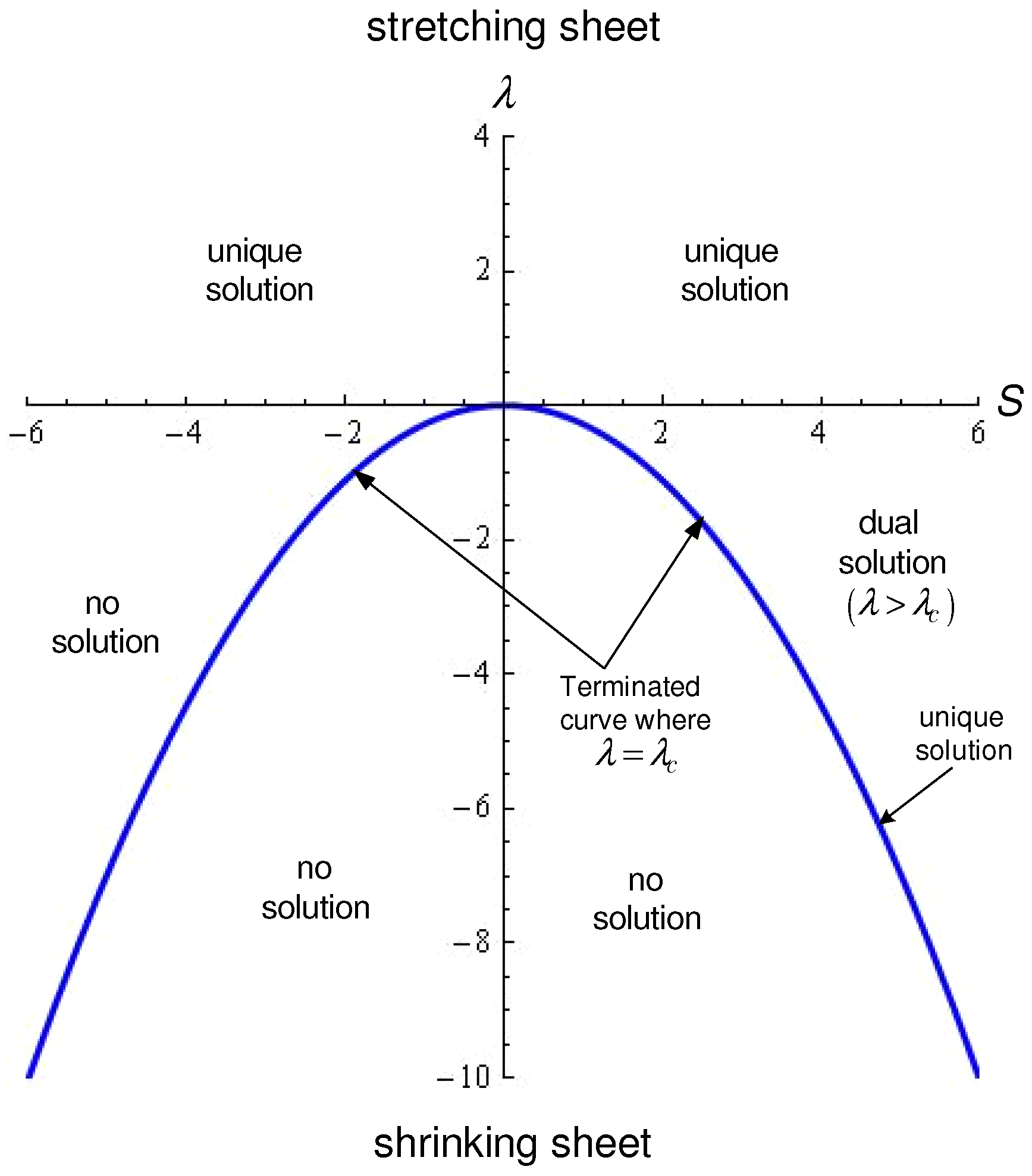
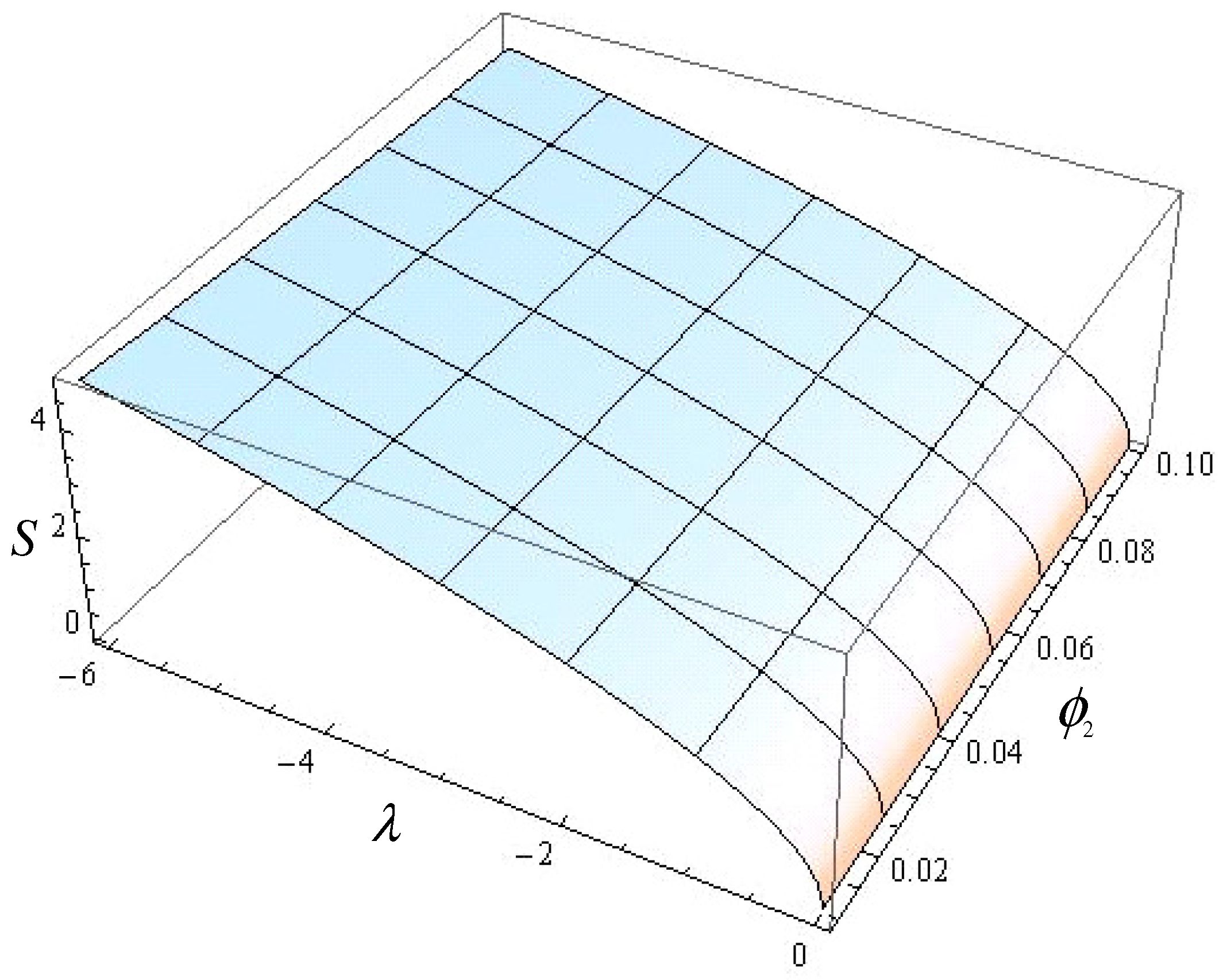
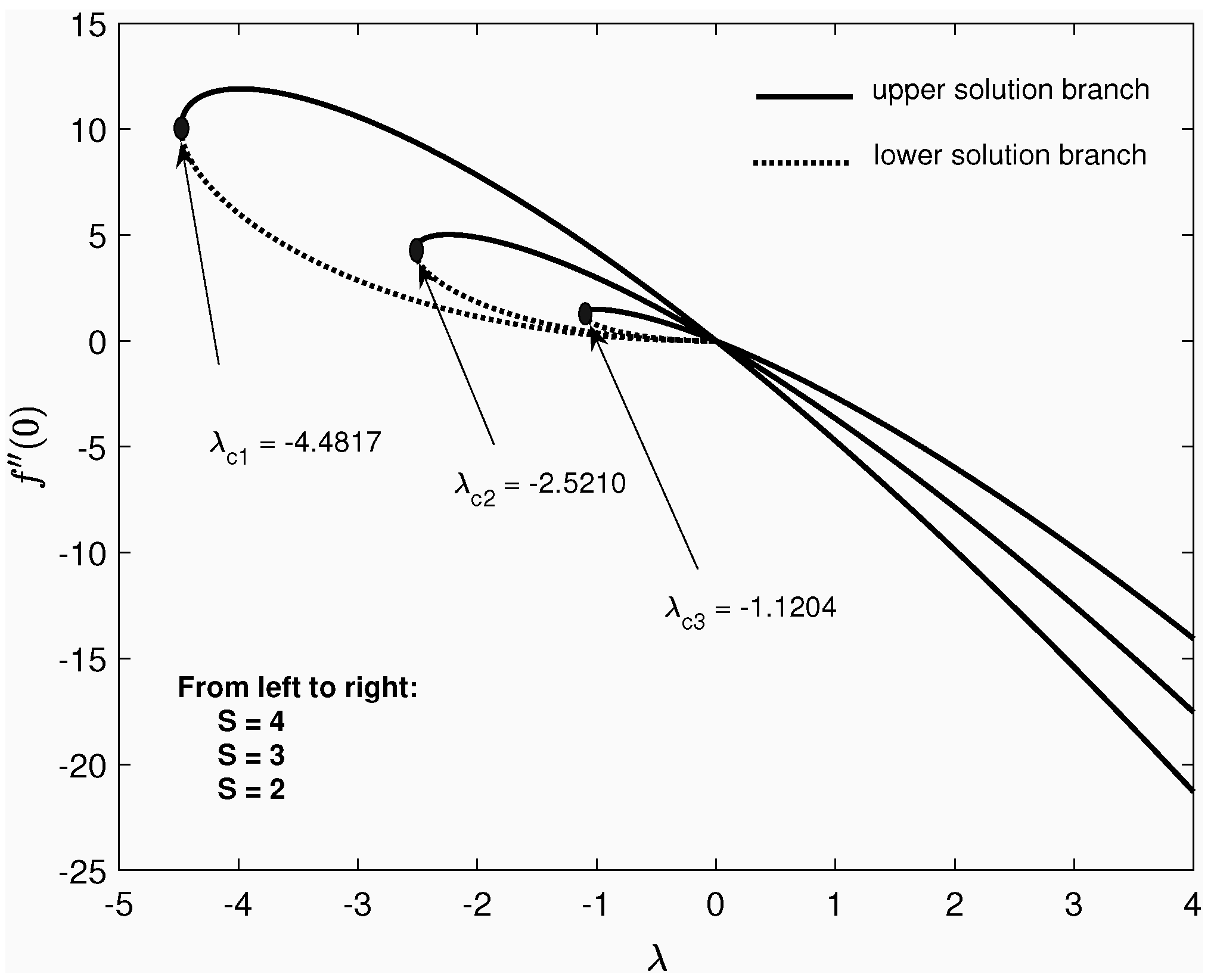

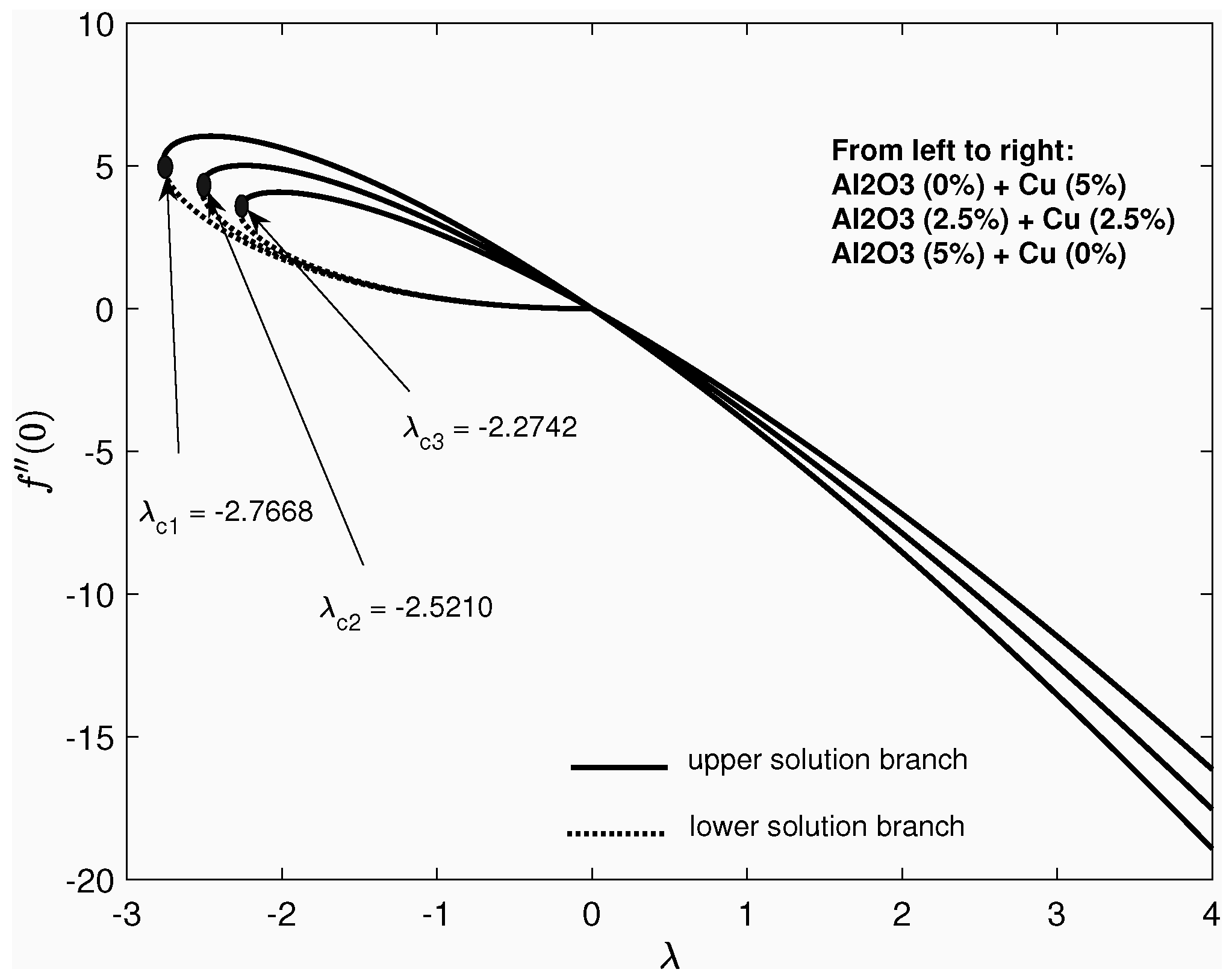

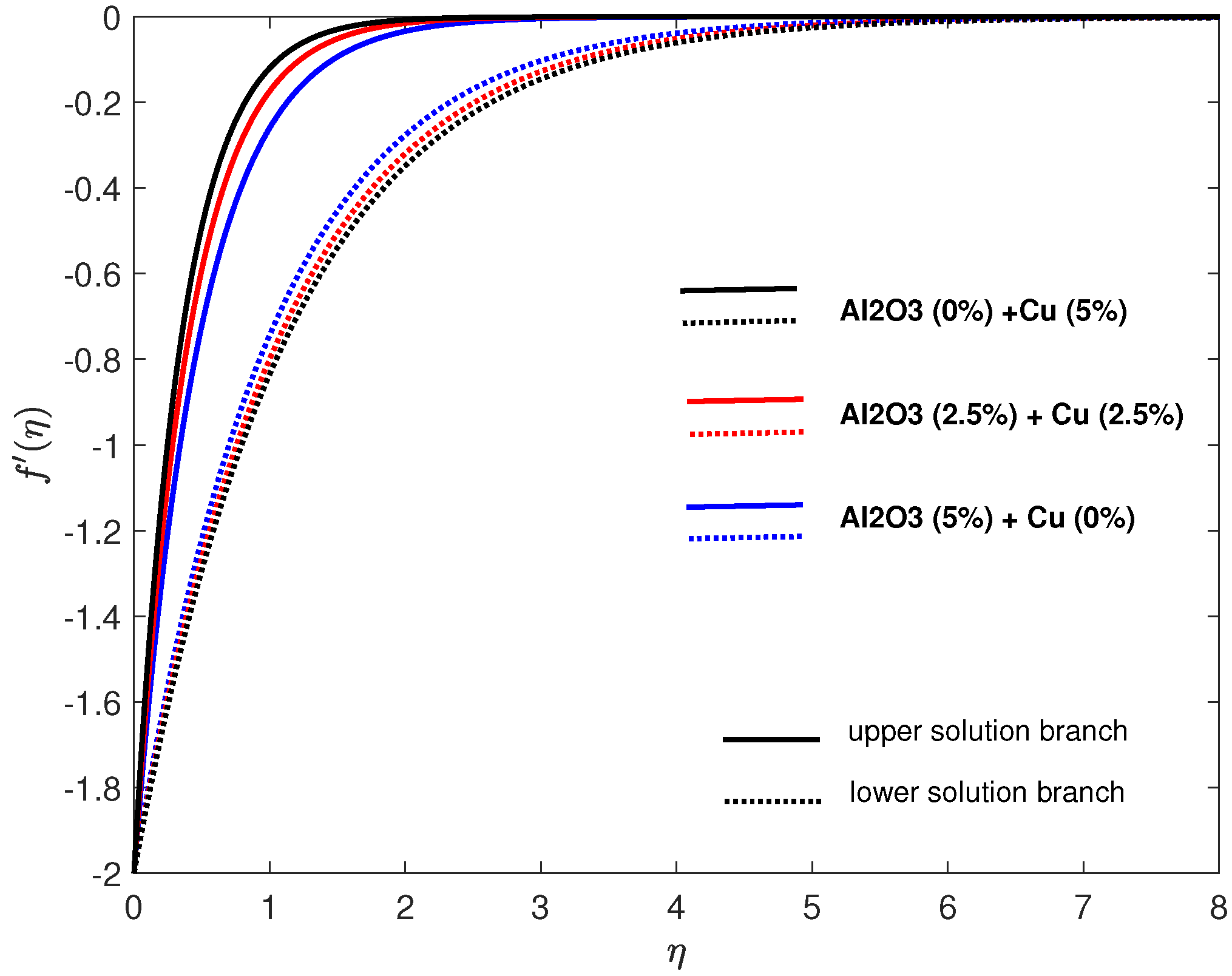

| Physical | Base Fluid | Nanoparticles | |
|---|---|---|---|
| Properties | Water | Cu | |
| (kg/m3) | 997.1 | 3970 | 8933 |
| (J/kg K) | 4179 | 765 | 385 |
| k (W/m K) | 0.613 | 40 | 401 |
| (/m) | 0.05 | 1 | 5.96 |
Publisher’s Note: MDPI stays neutral with regard to jurisdictional claims in published maps and institutional affiliations. |
© 2021 by the authors. Licensee MDPI, Basel, Switzerland. This article is an open access article distributed under the terms and conditions of the Creative Commons Attribution (CC BY) license (https://creativecommons.org/licenses/by/4.0/).
Share and Cite
Roşca, N.C.; Roşca, A.V.; Aly, E.H.; Pop, I. Flow and Heat Transfer Past a Stretching/Shrinking Sheet Using Modified Buongiorno Nanoliquid Model. Mathematics 2021, 9, 3047. https://doi.org/10.3390/math9233047
Roşca NC, Roşca AV, Aly EH, Pop I. Flow and Heat Transfer Past a Stretching/Shrinking Sheet Using Modified Buongiorno Nanoliquid Model. Mathematics. 2021; 9(23):3047. https://doi.org/10.3390/math9233047
Chicago/Turabian StyleRoşca, Natalia C., Alin V. Roşca, Emad H. Aly, and Ioan Pop. 2021. "Flow and Heat Transfer Past a Stretching/Shrinking Sheet Using Modified Buongiorno Nanoliquid Model" Mathematics 9, no. 23: 3047. https://doi.org/10.3390/math9233047






